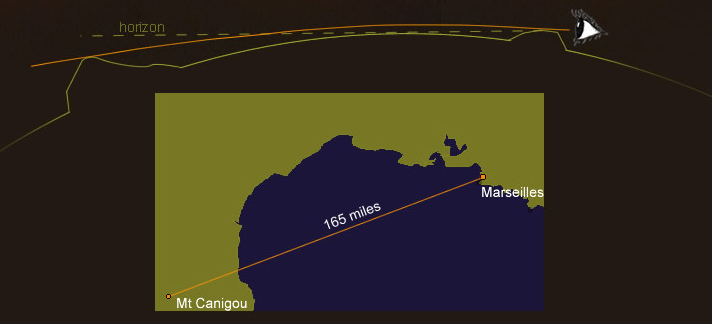Over the horizon mountain
Over the Horizon Mountain: A Spectacular Atmospheric Optics Phenomenon
Have you ever wondered how it is possible to see a mountain on the horizon, even when there should be no direct line of sight due to the Earth's curvature? The answer lies in the fascinating world of atmospheric optics. In this article, we will delve into the phenomenon of seeing mountains over the horizon and explore the science behind it.
One remarkable example of this phenomenon is captured in an image taken by Alain Origne of Laboratoire Astrophysique Marseille. The photograph showcases the Carnigou Massif in the Pyrenees, located 165 miles away from the observer. What makes this image truly extraordinary is not just the presence of a mock-mirage green flash, but also the silhouette of a mountain against the solar disk.
Alain Origne was positioned on a 1000 ft hill near Marseilles, France, overlooking the Mediterranean Sea. The silhouette visible in the image belongs to Mt Roc Negro, which stands at an impressive height of 8900 ft and is part of the Canigou Massif. Despite the considerable distance, the mountain's silhouette is visible due to the phenomenon of light refraction.
The curvature of the Earth would typically prevent a direct line of sight to distant objects beyond the horizon. However, in this case, light undergoes refraction as it passes through different layers of the atmosphere with varying densities. This refraction causes the sun to appear higher by approximately 0.5° when it is at the horizon, and it can also elevate very distant terrestrial objects, such as mountains.
Alain Origne's observation is not merely a chance occurrence. In fact, he has conducted a systematic study of this phenomenon and has even developed predictions for when it is likely to occur. He encourages others to share their experiences of long-distance sightings, further contributing to our understanding of this captivating atmospheric optics phenomenon.
The ability to see mountains over the horizon opens up a world of possibilities for photographers, nature enthusiasts, and scientists alike. By studying these distant silhouettes, we can gain valuable insights into atmospheric conditions, light refraction, and the complex interplay between Earth's curvature and the atmosphere.
In future OpticsPOD articles, we will explore other instances of this phenomenon, including lunar views of distant mountains. By examining these celestial interactions, we can continue to unravel the mysteries of atmospheric optics and deepen our appreciation for the beauty and intricacy of our natural world.
To conclude, the sighting of mountains over the horizon is a captivating demonstration of the power of light refraction and the remarkable interplay between Earth's curvature and the atmosphere. Through systematic study and observation, scientists like Alain Origne have shed light on this phenomenon and are eager to hear about other instances of this extraordinary occurrence. So, the next time you find yourself gazing at the horizon, keep an eye out for the silhouette of a distant mountain and marvel at the wonders of atmospheric optics.

The Carnigou Massif in the Pyrenees from 165 miles away imaged October 26, '08 by Alain Origne of Laboratoire Astrophysique Marseille (more images). Image ©Alain Origne, shown with permission.
What is remarkable about these images is less the mock-mirage green flash (see the animation) but that the top of a mountain in the distant Pyrenees can be seen silhouetted against the solar disk.
Alain was on a 1000 ft hill near Marseilles, France and looked out across the Mediterranean. The silhouette is of 8900 ft Mt Roc Negro, part of the Canigou Massif 165 miles distant.
There is no direct line of sight to the mountain because of the Earth's curvature. The view is only possible because light is refracted around the earth by passage between the dense lower and less dense upper regions of the atmosphere. This refraction raises the sun by ~0.5° when it is at the horizon and it can raise very distant terrestrial objects also.
This is not a chance observation, Alain Origne has made a systematic study of the phenomenon and predicts when it will occur. He would like to hear of other long distance sightings.
See next OpticsPOD for lunar views of distant mountains.

Note: this article has been automatically converted from the old site and may not appear as intended. You can find the original article here.
Reference Atmospheric Optics
If you use any of the definitions, information, or data presented on Atmospheric Optics, please copy the link or reference below to properly credit us as the reference source. Thank you!
-
<a href="https://atoptics.co.uk/blog/over-the-horizon-mountain/">Over the horizon mountain</a>
-
"Over the horizon mountain". Atmospheric Optics. Accessed on November 26, 2024. https://atoptics.co.uk/blog/over-the-horizon-mountain/.
-
"Over the horizon mountain". Atmospheric Optics, https://atoptics.co.uk/blog/over-the-horizon-mountain/. Accessed 26 November, 2024
-
Over the horizon mountain. Atmospheric Optics. Retrieved from https://atoptics.co.uk/blog/over-the-horizon-mountain/.